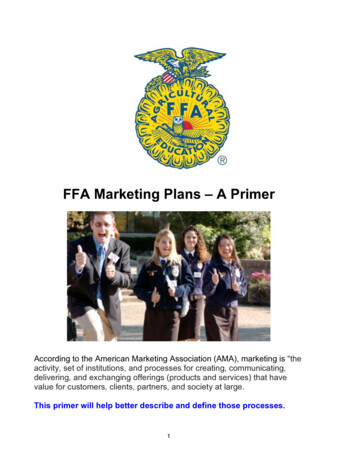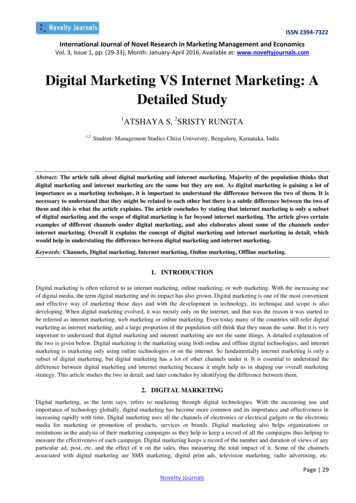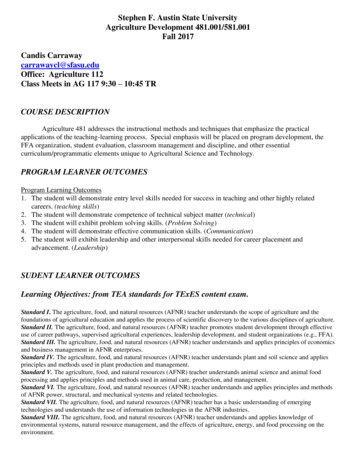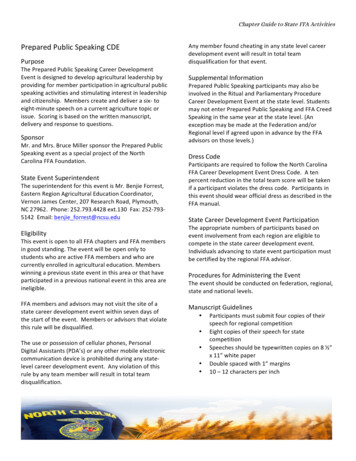
Transcription
FFA Marketing Plans – A PrimerAccording to the American Marketing Association (AMA), marketing is “theactivity, set of institutions, and processes for creating, communicating,delivering, and exchanging offerings (products and services) that havevalue for customers, clients, partners, and society at large.This primer will help better describe and define those processes.1
Table of Contents1 Know your Product - ServiceFeatures and BenefitsUnique Selling Proposition (USP)Can your product be easily copied?Cost to produce your productAccounting SoftwareSWOT AnalysisStrengthWeaknessOpportunitiesThreatsHow to write a SWOT Analysis“Erica’s Green Garden” Demonstration ExampleMcDonalds Corporation SWOT AnalysisPepsiCo SWOT AnalysisHow do I find information to create a SWOT Analysis?2 Know your CompetitorsWhat and who are your competitors?The Competitive AdvantageHow do you research your competitors?Social Media – A Research Station3 Your Target MarketProspect your Customer!Know your CustomerResearch – Primary and Secondary4 Distribution NetworkSell Direct to the ConsumerThe InternetOne-On-One SalesDirect Media SalesRetail Sales; Using a DistributorThe Supply ChainDo You Require a Sales Team?Resources2
5 Managing Business FinancialsRolling Hill’s Bee Company – ExampleOverview of BusinessIncome StatementUnderstanding the cost of managing a businessKey areas to manageDepreciationLiability InsuranceAccounting TermsResources6 Developing Company GoalsS.M.A.R.T GoalsFinancial GoalsAwareness and Media GoalsSales GoalsSetting Sales GoalsMarket Penetration GoalsMission StatementWriting your Mission StatementGoal SummaryResources7 Developing An Action PlanProduct (or Service)Unique Selling Proposition (USP)Product MessagingPositioning StatementPriceMarket ValuePlaceDistribution ProcessDistribution ChannelPromotionPublic Relations (PR)Media RelationsEducational MaterialAdvertisingTraditional MediaNew MediaPrint MediaElectronic Media3
Internet AdvertisingOutdoor MediaMobile MediaPoint-Of-SalePremiumsSocial MediaSales SupportCo-op AdvertisingResources8 Budget and ROIMarket Strategy CostMarketing Plan CostRolling Hill’s Bee Company Expenses (Example)Marketing Plan ROIPro Forma Income StatementIncome Statement Year 1 – Benchmark (Example)Pro Forma Income Statement – Projected Year 2 (Example)Marketing MetricsCommon Metric ToolsResources9 Careers in MarketingMarketing’s FutureProfessional Marketing CareersAdvertising / PR AgenciesAccount Management / Account ServiceCreativeMediaProduction ServicesNot-For-Profit / EducationResourcesGlossaryMarketing Plans – A PrimerWritten by: Michael K Shaw MBA, 2011, Shawnee, Kansas4
1Know your Product - ServiceProducts are goods that satisfy the needs of the consumer. A product is a tangible.Examples of products: a truck, a farm implement, a food product, garden plants.A service can be a task, a repair, an activity, or an idea performed or developed tomeet the needs of the buyer. It is intangible and cannot be handled or viewed beforepurchased. Examples of services: lawn care, shipping/delivery services, pet-sitting.Whether it’s a tangible or intangible good, know your product, the competition, and thecustomer. To be successful, do the homework and study all aspects of your product’sprocess. How does your product compare against the competition? Know not only yourproduct, but also every company and their product(s) that attract the same customerbase. Know your customer and their locations and buying habits. This information mustbe documented and analyzed before you hit the market.1. Features and Benefits.It’s important to thoroughly understand your product/service.- Why does your product exist?- Why do consumers purchase it?- How do consumers use it?- How does it compare to the competitions product?- How much does it cost to produce?- What education and knowledge is required to perform your service?- How much can you sell it for?2. Unique Selling Proposition (USP)The unique selling proposition is what you as a marketer identify as a uniquecharacteristic of your product/service. This characteristic sets you apart from otherproducts/services in your market. This unique characteristic is also the basis used inpromoting and advertising your product.3. Can your product/service be easily copied?Products or services that can be easily copied or duplicated may not have a uniqueselling point by themselves. These products do not normally have a long life cycle orlarge profit margin. In this case, you will need to find a way to make your product orservice more attractive to buyers thorough other means, for example, a lower price,free delivery, longer warranties, etc. To make an impact, find that unique sellproposition and use it to create a benefit for your customer.4. Cost to produce your productKnow exactly how much your product costs to produce. Identify all elements involved inthe development of your product.5
Include the investment to design and develop your product. Remember, your time is anexpense. This research and development (R&D) should also be an expense in youraccounting ledger Determine your cost per hour. Did you build a prototype? What didthat prototype cost to manufacture and test? Track these costs.Is your product packaged? What is the best way to package your product? Eachelement of that packaging needs to be accounted for. How is your product distributed?Are you placing multiple products in a carton? Let’s say you place 12 (twelve) items ina carton. There’s a cost for that master carton, and a price per each individualpackage. If it ships to a store, what does that cost?Examples of sExpenses(Bonuses,discounts,etc.)In no particular order, five top brands of accounting software include*:1) QuickBooks - a trusted named in software, QuickBooks accepts credit cardpayments and imports spreadsheet files, and also allows multiple users to access andupdate the system simultaneously.2) Peachtree Complete - a top name in the industry, Peachtree provides a flexibleintegration that allows users to import data from other accounting programs. Mostversions of Peachtree offer as many as 75 different templates for billing, payroll, andA/R.3) DacEasy - for a small business in need of the basics, DacEasy is a good option.There's nothing too fancy, just straightforward options for billing and inventory andother functions.4) NetSuite - if you handle sales over the Internet, NetSuite offers options forecommerce most will find invaluable. That the program breaks down functionalityaccording to the different roles in your office is a plus.6
5) MYOB Business Essentials - you can import bank statements, customize forms,and navigate your accounts with ease.When you are ready for an accounting solution for your business, talk with aprofessional consultant about these or other programs.* Article Source: http://EzineArticles.com/32484A Product’s Life CycleEverything in this world has a life cycle, even products. When we look at a product lifecycle, we see: an introduction to the market; market growth; stabilization or maturity ofthe product; and a decline in the product due do to new technologies or bettersubstitutes in the market.When you compare your product to your competitor’s, look at what they are currentlyusing. Does your product replace their current product or does it give them an alternatechoice in products? Do you have the competitive edge?Also look at the usage of your product and the market in which it resides.a. Is your product a once-in-a-lifetime purchase?b. Is it a novelty item?c. Do you use it daily?d. Is it a consumable item that is replaced often; soap, a food item, or a paperproduct?e. Is it a service that is required on a regular basis such as lawn care or householdrepairs?f. Know your product and your consumer’s usage of that product.SWOT AnalysisSo, what does SWOT stand for?S Strengths - internalW Weaknesses - internalO Opportunities - externalT Threats - externalA company must always look inward to evaluate their strengths and weakness.Then look externally for growth opportunities, and threats that may affect their business.When doing an analysis, you are comparing your business or product to that of yourcompetitors’. To perform a proper SWOT Analysis, you must identify your competitors andbusinesses that offer similar products or services. It’s very important that you know:- Your product and it’s features and benefits- Your business- Who your competitors are, along with their features and benefits- What are the competitive products in your target market area7
How to write a SWOT AnalysisStrengths: Make a list of your business and product strengths. Remember, your strengthsare internal aspects of your business and product that give you a competitive advantage.What do you do or what does your product offer that your competitors may not?- A good reputation in your market or community- Resources that may not be available to your competition- A skilled and knowledgeable workforce- A cost advantage- A good distribution networkWeakness: Make a list of your internal weaknesses. These can be disadvantages yourmay have that your competition may not. What areas give your competition an advantagein the market?- Your product is unknown in comparison to your competition. Your brand name is weak.- Maybe your staff is not as skilled as your competition- Have your customers had problems with your product or service?- Your distribution channels are not fully developed- You do not have sufficient resources and capital (money) to invest in your businessOpportunities: These are external circumstances, events, or consumer needs thatcreate opportunities for your business to expand and grow.A customer need that your competitors do not fulfill- A mechanical or technical improvement- Your cost and process to manufacture your product is more efficient and less to build- Partnerships- Seasonal opportunities-Threats: Now make a list of external threats that may affect or harm your product’sfuture. A change in the external environment can create unfavorable results for yourbusiness.New products on the market may make your product or service obsolete- Raw material costs may rise- Parts may not be readily available and delay the manufacturing of your product- A workers strike may delay delivery and distribution services- Economy-Performing a SWOT Analysis is essential to understanding the future and success ofyour product, your business and how you will compare to your competitors in the eyes ofthe consumer.NOTE: Whenever you perform an analysis, research, or gather data, it is essential yougather the most recent data available. Note the dates of all surveys and data you gather.Changes in business, cost structures, and environmental conditions can happen at anytime.8
LetslookatabasiccompanySWOTanalysissample Erica’sGreen GardenErica’s Green Garden is a start up business. Thebusiness provides garden fresh salad greens to localmarkets and produce stores, right from the their farmstore. EGG prides itself on high-quality organic fieldsalad greens. EGG grows a variety of greens including: Arugula, Bibb lettuce, Cress,Dandelion Greens, Red Lettuce varieties, Green Leaf varieties, Spinach, and Chicories.SWOTAnalysisThis SWOT Analysis identifies the key strengths and weaknesses within “Erica’s GreenGarden”. It also points out the opportunities and threats faced by this business.StrengthsFlexibility in meeting the needs of customers: restaurants, produce stores, markets, andlocal consumers.High-quality organic produce exceeding competitors’ offerings of price, quality, andservice.Operations very efficient and overhead is low giving the company a higher than averageprofit margin. WeaknessesErica’s Green Garden lacks brand recognition compared to other competitive brands.EGG has limited marketing budgetsProduction and acreage space is limited for long-term expansion. OpportunitiesEEG has great opportunity to expand name recognition within the market.There is opportunity to establish long-term contracts with current and future retailers.Current production has capacity to expand sales with limited expenses. ThreatsLarger growers having greater capacity and service available to same customer base.A health alert that questions the safety of vegetables.Unpredictable weather, which can affect production and may cause lower yields. 9
Now lets look at some popular brands and their SWOT analysis To understand how a SWOT Analysis works, lets look at some major companies andtheir published SWOT Analysis. These SWOT Analysis profiles are actual evaluationsfrom the companies listed. Very detailed, these analyses are publicly listed foreducational purposes. Please note that smaller companies will be detailed as well but ina scale to match each specific companies analysis.McDonaldsCorporationSWOT ANALYSISStrengths McDonalds has built up huge brand equity. It is the No. 1 fast-food company bysales, with more than 31,000 restaurants serving burgers and fries in almost 120countries. Sales, 2007 (11,4009 million), 5.6% sales growth[1].Good innovation and product development. It continually innovates to retaincustomers in the business.The McDonalds brand offers consumers choice, reasonable value and greatserviceLarge amounts of investment have gone into supporting its franchise network,75% of stores are franchises[2].Loyal staff and strong management team.Weaknesses Core product line out of line with the trend towards healthier lifestyles for adultsand children. Product line heavily focused towards hot food and burgers[3].10
SeasonalQuality issues across the franchise network.Opportunities Joint ventures with retailers (e.g. supermarkets).Consolidation of retailers likely, so better locations for franchisees.Respond to social changes - by innovation within healthier lifestyle foods. Its moveinto hot baguettes and healthier snacks (fruit) has supported its new positioning.Use of Customer Relationship Management, database marketing to moreaccurately market to its consumer target groups. It could identify likely customers(based on modeling and profiles of shoppers) and prevent brand switching[4].Strengthen its value proposition and offering, to encourage customers who visitcoffee shops into McDonalds.The new “formats”, McCafe, having Wifi Internet links should help in attractingsegments. Also installing children’s play-parks and its focus on educatingconsumers about health, fitness.Continued focus on corporate social responsibility, reducing the impact on theenvironment and community linkages.International expansion into emerging markets of China and India.Threats Social changes - Government, consumer groups encouraging balanced meals, 5 aday fruit and vegetables.Focus by consumers on nutrition and healthier lifestyles.Competitive pressures on the high street as new entrants offering value andgreater product ranges and healthier lifestyles products. E.g. subway,supermarkets, M&S.Recession or down turn in economy may affect the retailer sales, as householdbudgets tighten reducing spend and number of visitors.Pressure groups - environmental.[1] Hoovers (2008), http://www.hoovers.com/mcdonald’s/–ID 10974–/freeuk-cofactsheet.xhtml[2] McDonalds Annual Report (2008)[3] http://www.dlea.com.au/?Community/Health and Nutrition/Health and Nutrition[4] Jobber, (2006), Principles and Practices of Marketing, 3rd Edition11
PepsiCoSWOT AnalysisStrengths Branding - One of PepsiCo’s top brands is of course Pepsi, one of the mostrecognized brands of the world, ranked according to Interbrand. As of 2008 itranked 26th amongst top 100 global brands. Pepsi generates more than 15,000million of annual sales. Pepsi is joined in broad recognition by such PepsiCobrands as Diet Pepsi, Gatorade Mountain Dew, Thirst Quencher, Lay’s PotatoChips, Lipton Teas (PepsiCo/Unilever Partnership), Tropicana Beverages, FritosCorn, Tostitos Tortilla Chips, Doritos Tortilla Chips, Aquafina Bottled Water,Cheetos Cheese Flavored Snacks, Quaker Foods and Snacks, Ruffles PotatoChips, Mirinda, Tostitos Tortilla Chips, and Sierra Mist. The strength of these brands is evident in PepsiCo’s presence in over 200countries. The company has the largest market share in the US beverage at 39%,and snack food market at 25%. Such brand dominance insures loyalty andrepetitive sales which contributes to over 15 million in annual sales for thecompany Diversification - PepsiCo’s diversification is obvious in that the fact that each ofits top 18 brands generates annual sales of over 1,000 million. PepsiCo’s arsenalalso includes ready-to-drink teas, juice drinks, bottled water, as well as breakfastcereals, cakes and cake mixes. This broad product base plus a multi-channeldistribution system serve to help insulate PepsiCo from shifting business climates.Distribution - The company delivers its products directly from manufacturingplants and warehouses to customer warehouses and retail stores. This is part of athree pronged approach which also includes employees making direct store 12
deliveries of snacks and beverages and the use of third party distribution services.Weakness Overdependence on Wal-Mart - Sales to Wal-Mart represent approximately 12%of PepsiCo’s total net revenue. Wal-Mart is PepsiCo’s largest customer. As aresult PepsiCo’s fortunes are influenced by the business strategy of Wal-Martspecifically its emphasis on private-label sales which produce a higher profitmargin than national brands. Wal-Mart’s low price themes put pressure onPepsiCo to hold down prices.Overdependence on US Markets - Despite its international presence, 52% of itsrevenues originate in the US. This concentration does leave PepsiCo somewhatvulnerable to the impact of changing economic conditions, and labor strikes. LargeUS customers could exploit PepsiCo’s lack of bargaining power and negativelyimpact its revenues.Low Productivity - In 2008 PepsiCo had approximately 198,000 employees. Itsrevenue per employee was 219,439, which was lower that its competitors. Thismay indicate comparatively low productivity on the part of PepsiCo employees.Image Damage Due to Product Recall - Recently (2008) salmonellacontamination forced PepsiCo to pull Aunt Jemima pancake and waffle mix fromretail shelves. This followed incidents of exploding Diet Pepsi cans in 2007. Suchoccurrences damage company image and reduce consumer confidence inPepsiCo products.Opportunities Broadening of Product Base - PepsiCo is seeking to address one of its potentialweaknesses; dependency on US markets by acquiring Russia’s leading JuiceCompany, Lebedyansky, and V Wwater in the United Kingdom. It continues tobroaden its product base by introducing TrueNorth Nut Snacks and increasing itsLipton Tea venture with Unilever. These recent initiatives will enable PepsiCo toadjust to the changing lifestyles of its consumers.International Expansion - PepsiCo is in the midst of making a 1,000 millioninvestment in China, and a 500 million investment in India. Both initiatives arepart of its expansion into international markets and a lessening of its dependenceon US sales. In addition the company plans on major capital initiatives in Braziland Mexico.Growing Savory Snack and Bottled Water market in US - PepsiCo ispositioned well to capitalize on the growing bottle water market which is projectedto be worth over 24 million by 2012. Products such as Aquafina, and Propel arewell-established products and in a position to ride the upward crest. PepsiCoproducts such as, Doritos tortilla chips, Cheetos cheese flavored snacks, Tostitostortilla chips, Fritos corn chips, Ruffles potato chips, Sun Chips multigrain snacks,Rold Gold pretzels, Santitas are also benefiting from a growing savory snackmarket which is projected to grow as much as 27% by 2013, representing anincrease of 28 million.13
Threats Decline in Carbonated Drink Sales - Soft drink sales are projected to decline byas much as 2.7% by 2012, down 63,459 million in value. PepsiCo is in the processof diversification, but is likely to feel the impact of the projected decline.Potential Negative Impact of Government Regulations - It is anticipated thatgovernment initiatives related to environmental, health and safety may have thepotential to negatively impact PepsiCo. For example, manufacturing, marketing,and distribution of food products may be altered as a result of state, federal orlocal dictates. Preliminary studies on acrylamide seem to suggest that it maycause cancer in laboratory animals when consumed in significant amounts. If thecompany has to comply with a related regulation and add warning labels or placewarnings in certain locations where its products are sold, a negative impact mayresult for PepsiCo.Intense Competition - The Coca-Cola Company is PepsiCo’s primarycompetitors. But others include Nestlé, Groupe Danone and Kraft Foods. Intensecompetition may influence pricing, advertising, sales promotion initiativesundertaken by PepsiCo. Recently Coca-Cola passed PepsiCo in Juice sales.Potential Disruption Due to Labor Unrest - Based upon recent history, PepsiComay be vulnerable to strikes and other labor disputes. In 2008 a strike in India shutdown production for nearly an entire month. This disrupted both manufacturingand distribution.PepsiCo is a world leader in convenient snacks, foods and beverages with revenues ofmore than 43 billion and over 198,000 employees.Disclaimer:Erica’s Green Garden is a speculative company and designed as an educationalSWOT exampleThe case studies for McDonalds, and PepsiCo have been obtained from informationfreely available on public web sources.These studies are intended to be used for educational purposes only.How do I find information to create a SWOT Analysis?There are many resources available to gather information on SWOT and yourcompetitors. The internet is a great place to start. Be sure to document all your research14
by dates, sites utilized and studies you use. Many universities and college businessschools release research as well.Companies release quarterly and annual reports. These are published as public record.Go to the company’s web site and look at their financial and stock reports.You may want to purchase software to perform a SWOT Analysis. Several companiesoffer business organizational software. You can also find free software available, as well.Review ratings and features on all software before you purchase or download.A few sites you may want to review as you plan your companies SWOT diagram.php15
2Know your CompetitorsFor a product to be successful, the product needs to stand out from its competitors’offerings. This is called product differentiation. In promoting your product, you need toidentify those aspects of the product that are different and add value for buyers.What and who are your competitors?Your competitors are rival companies engaged in the same business and focused onthe same customer base. Within your market, there may be one major competitor ormany companies competing for the same customer.As we reviewed in Chapter 1, it’s extremely important to know your products’ Part of your marketing research is to identify all companies competing for your samecustomers. Now, you must know your competitors’ SWOT to the same degree as youknow your product. Doing your homework will help you make sound businessdecisions.The Competitive AdvantageCompare your SWOT to that of your competitors. Identify features and benefitspossessed by both your product and that of your competitor. A good marketer will benon-biased and open to the fact that their competitor may actually have a better featurethen your product. This is good information to have. Use that information to improveyour product or to identify a difference in your product that may actually present itselfas a selling point.Here are some questions to discuss Who is your customer?Businesses? Consumers? Or is it both business and consumers?What type of customer buys your product?Women? Men? Teenagers? Tradesmen? Farmers? Office Staff?.and so on.16
Is your service or product unique and not currently offered to consumers?What do you offer that your competitors do not?What is the biggest feature that makes you different from your competitor?How will your competitors react to your product/service and marketing approach?Here’s what you will come away with:Your USP (Unique Selling Proposition). This is the unique characteristic or feature thatseparates your product from the rest. This unique feature is the basis for yourpromotions and marketing campaigns.Your Positioning Statement. This is how your customers will view you and yourproduct/service. For example, John Deere positions their products as highquality, high-value.How do you research your competitors?There are many ways to get to know your competitors. Go to their stores. Review theirproducts. Talk to their salespeople. Buy a sample of their products, if you can afford it.If you’d like to get an unbiased report on competitors’ products/services, ask those whouse those products/services. Traditionally, product reviews were done with focusgroups. A focus group is a gathering of 6-10 potential customers in your market. Amoderator leads a survey and discussion of related products to get the group’sviewpoint, understanding and tendencies to buy. What you will get is honest, unbiasedand unsolicited feedback.For your project, you can bring together a focus group to get a basic understanding ofhow and why people use competitors’ product. A survey taken over the phone or inperson can also be valuable. Be prepared. The feedback you get might not be whatyou hoped for. But it will be a good example of how the consumer will react whenmaking a buying decision.Of course, the Internet is a great resource for gathering information about competitivecompanies products, and services. Google them. Go to their websites and review theirofferings and their annual reports. You can glean plenty of information by searchingthese sites.17
Social Media – A Research StationA “Research Station” is nothing more than a way to use networks on the web to gatherinformation about your market, your product, or your competitors. Some of thisresearch is free, but for higher-level information, you may have fees. Include thesecosts in your marketing budget as a marketing research expense. Spend timeorganizing your research. Here are a few tools available to build your research station.Google Alerts will give you a consumer’s opinion on your company and lume:Youremail:CREATE ALERTGoogle Alerts are email updates of the latest relevant Google results (web, news, etc.)based on your choice of query or topic.Enter the topic you wish to monitor, then click preview to see the type of results you'llreceive. Some handy uses of Google Alerts include: Monitoring a developing news storyKeeping current on a competitor or industryGetting the latest on a celebrity or eventKeeping tabs on your favorite sports teamsYou can also sign in to manage your alertsCheck out these other resources available on the web:Social MentionTwitter SearchFacebook Search18Google Analytics
3Your Target MarketDo you know who will buy and use your product? Why?How often will they buy? What are they willing to pay?Is your product focused on a specific customer?Is your product used in a specific area of the country?There’s no doubt you should know you product/service.You need to know your customer, as well. The more youknow about your customers – how, where, why they buy– the greater the potential for your success.The term marketing segment refers to a specific group of buyers who share similarcharacteristics. Customer profiling identifies the characteristics of that buyer. Yourbuyer may be classified as an average age, gender, income or salary bracket,interested in sports, or even listen to a particular genre of music, books, or movies.Your target market can be defined in two basic ways, either a Business-to-Businessmarket or a Business-to-Consumer market. These two distinct market types will requirevery different marketing approaches.Business-to-Business marketing (B2B): You’ll be promoting and selling a product orservice to another business. Examples include:a. A handle designed for the furniture industryb. An Original Equipment Manufacturer (OEM) attachment for a tractorc. A feed additive for cattle, sold through feed millsB2B buyers are looking for ways to improve their profitability, attract more customers totheir retail stores and improve their company operations. These prospects areconcerned about margins, the amount they can charge their customers above whatthey paid for your product. They’re interested in offering something unique to interesttheir customers. And, they must be able to rely on their suppliers.Business-to-Consumer marketing (B2C): You’ll be promoting and selling a product orservice directly to the end-user or consumer. Examples include:a. Setting up a plant sale at your greenhouseb. A food product for health conscience consumersc. A lawn service offering specific services not ordinarily offered by other services.These items may be sold through retail stores, on-line, through catalogs or direct mail.The difference here is that you will be marketing directly to the end-user.19
Product/service attributes and Unique Selling Propositions become more personal,more important.To kno
1) QuickBooks - a trusted named in software, QuickBooks accepts credit card payments and imports spreadsheet files, and also allows multiple users to access and update the system simultaneously. 2) Peachtree Complete - a top name in the industry, Peachtree provides a flexible integration that allows users to import data from other accounting .











